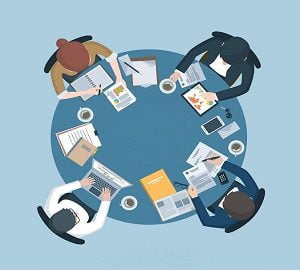Editorial Board

The editorial board is usually made up of prominent individuals in the field of journalism. Having an editorial board is very important: “They act as ambassadors of the press”. The quality of the journal is largely judged by its members and educational degrees. The role of the editorial board is to guide and support the editor.
The duties of the editorial board include the following:
- Identify new topics for articles
- Provide special edits and recommendations to journal managers
- Give feedback on recent issues
- Suggest a scientific topic for probable topics and authors
- Perform peer review
- Identify those who can participate in the peer review process and provide constructive comments on the subject
- Support writers, readers, and subscribers of the journal
- Encourage colleagues more collaborate in a scientific journal
Diversity in Editorial Board

One of the basic principles to get your journal indexed is to invite an international and recognized editorial board.
Possessing an international editorial board as the primary criterion mentioned in the Society of Indexers, helps the journal impact factor improve.
However, including an international editorial board in the journal is one of the main reasons for the journal’s rejection at the initial stages. Conventionally, the editorial board was divided into two categories:
the active editors
the ceremonial ones.
On the one hand, the editorial board consisting of academic and active members plays a leading role in the indexation of the journal. On the other hand, given the high prevalence of ceremonial editorial boards, journal indexers consider it a drawback and mention it as one of the reasons to reject journal indexation.
In some cases, the journal indexers in the initial stage of evaluation, criticize the journal and the publisher for the presence of well-known and ceremonial editors, who are not active in the journal editing process. Therefore, it is strongly recommended not to invite international editorial boards merely for their recognition and specialties.
According to the recent indexer supervisions, it seems that ceremonial editors are forbidden to be included in the editorial board list.
Who is editor-in-chief

The editor-in-chief is in charge of producing scientific content and journal management.
It is important for which editor-in-chief to organize a managing team to lead scientific journals and guarantee the journal’s improvement. Also considering the interests and viewpoints of writers, readers, journal staff, editorial board, referees, and publisher should be done by the editor and making a suitable balance between the views of these groups. That is to say, the editor-in-chief has the responsibility of providing scientific content for journals. So he or she has to be well-informed, capable, and fully experienced in scientific subjects and be professional in his or her own field. An editor has to be completely aware of scientific methodology and all parts of scientific journals.
The editor-in-chief is selected by the publisher or financial sponsors and has been supported by the publisher. It is an undeniable issue that editor operation plays a crucial role in either improving the quality of a scientific journal or reducing its credibility of that. The editor has to arrange a group of staff in order for all of them to have the ability to boost the value of scientific content, edit journals and recognize the capabilities of journal staff. Such abilities can enhance, provided that they participate in influential and practical meetings.
When the editor-in-chief is selected with time conventional signature by the publisher or financial sponsors, it is really important which clarify the process details overview and define the meeting time schedule (meeting with a publisher, editorial board, staff, editors, distributors, and so on). Moreover, it has to be mentioned clearly in the contract that the publisher gives the total authority and franchise to editors for doing their responsibilities.
There is the possibility that considering the editor-in-chief as the journal managing editor. He or she is responsible for classifying and distinguishing the responsibilities and functions of all editor team members. As a direct impact of responsibilities classification, an editor-in-chief would be able to see a significant improvement in journal scientific content. On some occasions, an editor-in-charge can delegate all or a part of her or his duties to a person or a group from outside the journal office, however, he or she should manage and supervise the elected deputy.
The editor-in-chief and managing editor are two completely separate jobs that sometimes have overlapping tasks. These two titles are used interchangeably because the authors and readers of scientific journals and even other types of journals do not know their differences.
However, the truth is that they are two different jobs. It can be said that the editor is like the CEO of a company, whereas the managing editor is like the chief operating officer. Top journals usually have both of them, but smaller journals may not have a managing editor
The Role of the Editor in Chief

The editor-in-chief is in direct contact with the manager of the publication and is responsible for applying the desires and opinions of the board of directors as well as the proprietors of the journal. It is her/his job to determine the atmosphere, orientation, and policies of the journal. The editor-in-chief designs the overall format of the journal and assigns the rest of the work to the journal’s reliable staff.
Major and Minor Decisions
The editor-in-chief has the final say regarding the journal’s internal affairs. She/he is the one who finally confirms the content of the journal and approves the output of the journal. An editor-in-chief continually receives reports from the journal sections and studies them to identify and address the journal’s needs. She/he meets with the editorial board on a regular basis and responds to the needs of the audience by identifying the key issues. Other tasks of the chief editor are estimating the overall budget, making sure that it is provided, and also estimating the budget of various departments based on their needs and outputs.
Responsibilities of the Editor-in-Chief Outside of the Company
The editor-in-chief has contact not only with the board of directors of the publishing house but also with other agencies and departments. She/he is the one who deals with the problems outside of the journal and sometimes has to travel for this purpose. The chief editor is the representative of the journal outside of the company and has to attend various meetings and events.
The required skills of an editor-in-chief:
- Excellent writing and editing skills
- Ability to listen and interact effectively with others
- Knowledge of status analysis and quality control processes
- Ability to judge and make decisions in times of crisis as well as other times
- Ability to manage time and complete tasks on schedule
- Knowledge of communications and media and laws
- Knowledge of legal issues
- possession of an open mind and creativity
- Ability to withstand pressure and stress and deliver good performance in harsh conditions
- Ability to manage human and financial resources
- Familiarity with the needed software and the internet
Role of the chief editor in the reviewing process
Three persons namely the chief editor, the referee, and the author undertake the process of reviewing scientific journals. The chief editor is also qualified to apply his scientific opinions and judgments under the following two stages:
- Initial screening of the articles
- Journals reviewing
After the initial submission to the journal, each article should be examined by the chief editor or editorial staff in terms of the following criteria:
- Not be – submitted before in the same journal
- Not be – submitted before in the same publisher’s journals
- Lack of plagiarism of more than 10%
- Lack of technical deficiencies in the main files of the article including the cover letter, word file, and shapes.
- Lack of deficiencies in the content parts of the article, such as the abstract, references, materials, and methods.
- Full control of edited English format and edit quality.
- Full control of the authorship affiliations.
- the appropriateness of the scientific content and the association of the article subject with the journal subject
The chief editor will reject or return the article to the author at once in case of finding out any incongruities in the mentioned issues
Be careful, if the papers are screened precisely at this stage, fewer workloads will be transferred to the referee’s process, and much more time will be saved.
The secret of the high-speed reviewing process in the prestigious journals of the world is initial, immediate, and on-time article screening.
The Role of the Managing Editor

The role of managing editor varies in different journals, however, she/he is responsible for the day-to-day work of the journal and must report to the chief editor. The managing editor defines the work processes and makes sure that they are followed.
She/he should manage the budget and staff and also try to prevent any problems. Moreover, if any issues occur, the managing editor is the one who is responsible for resolving that issues. The managing editor needs to have strong communication skills and the capability to make plans. Interaction is the key characteristic of the managing editor.
Duties of a managing editor
1. Management Planning
The managing editor prepares the work plan to communicate the objectives and strategies to staff members (i.e., the editorial board, authors, graphics, and layout artists). She/he determines deadlines and keeps track of all the tasks so that they will be completed and delivered on time. The managing editor can also set deadlines earlier to prevent possible problems of late delivery so that the journal does not suffer from the probable shortcomings of its staff. Hence, it can be said that the managing editor is responsible for the schedule management of the journal.
2. Task Assignment
The managing editor is responsible for assigning various tasks to the right people, determining the importance of the material, and deciding about the page layout. She/he oversees the prepared material and organizes the scientific and technical editing processes. Furthermore, a managing editor must organize the proofreaders, chief editors, and editorial assistants and also approves the texts from a technical point of view. Editors are referred to the managing editor if they have any questions.
3. Staff Management
As a senior member of the editorial board, the managing editor plays a key role in recruiting and training new members. She/he has to make sure that each employee has a standard workload. Managing editor also helps newcomers to overcome challenges and enhance their skills.
4. Managing the Process of Accepting Articles
The managing editor is the first one who reads the submitted articles and reviews them to make sure that they have adhered to the standard format of the journal. Moreover, the managing editor must consider grammatical issues. If an article has problems in this regard, the managing editor will return it to its author to revise it. The managing editor should also follow the processes an article goes through, from acceptance to publishing.
Required skills of a Managing Editor:
- Writing and editing skills
- Good working relationship
- Decision-making ability
- Time management
- Organizational skills
- financial and schedule Management
- Communication skills
- Familiarity with the needed software and internet
Joint Efforts
The editor-in-chief and managing editor work together to ultimately meet the demands of the journal’s audience. Both of them attend different events and try to present a positive image of their organization. The editor-in-chief makes the major decisions and delegates them to the managing editor and oversees her/his performance. Recruitment and dismissal of the staff are their joint tasks, but the chief editor has the final say. Overall, the managing editor is responsible for the executive tasks, while the editor mostly makes decisions and supervises.
What Should Journals Without a Managing Editor Do?
Smaller journals might not have a managing editor and only have a chief editor. In such cases, the chief editor supervises the editors’ and editorial assistants’ work and sometimes edits articles as well. In this kind of journal, the chief editor is responsible for both of these positions. Therefore, she/he has to fulfill both the executive tasks and the daily work of the CEO regarding publishing and staffing. Since the journal is smaller, the responsibilities of the chief editor are limited, so she/he can handle both of the aforementioned tasks. Sometimes the chief editor assigns some executive tasks to managers of different sections and asks them to write work reports.
Editor’s role in increasing citation to articles
A detailed review of the monthly report: The editor can monitor articles by tracking the exact monthly citation.
It is better to monitor articles based on the written form and in accordance with their specifications (such as reference style and authors, etc.) There are two types of published articles: the first is articles with sufficient citations, and the second is articles with zero citations. Monitoring and the main treatment should be performed on these articles. For articles with zero-level citations, you can use the following methods:
- request authors to cite this article.
- Send emails to the authors of the same article and explain the method of citation
Monthly reminders and their ongoing monitoring with the help of a scientific team and publisher can increase the impact factor of a journal.
What Is the Role of the Associate Editor in Scientific Journals?
The presence of a full-time editor accompanied by at least three associate editors can play a key role in the success of any scientific journal. Usually, a scientific journal can have one or more associate editors who are selected by the journal manager.

After the journal manager, an associate editor plays the most important role in the journal. The tasks of an associate editor are as follows:
– Inviting the reviewers to join a project
– Monitoring the work of the reviewers
– Announcing the final decision made for the article
– Observing the reviewers’ comments on an article
The journal management system must provide the foundation needed for the presence of an associate editor. This system should at least have the following requirements:
- An Invitation System for Associate Editors: If an associate editor is invited to manage an article review, an invitation will be sent to him/her by email. So the associate editor can log in to the website, access the article and complete the project with the help of an advanced management system.
- An Invitation System for Reviewers: Each associate editor must select and invite at least three scientific and methodological reviewers. There are two methods of choosing reviewers. The associate editor can search them by the subject matter among the reviewers in the online system or by using the Medline search engine. One of the most important features of this system is direct access to the Medline database and all its variables. Thus, by using only the intended keywords, the assistant editor can send an online request to a Medline-registered researcher and invite her/him to review the article.
- A Second Editing Review System: The associate editor should review any article whose author has answered the reviewers’ comments and make a final decision whether to accept or reject it.
- Reviewers’ Performance Reporting Section: Associate editors can observe the performance of each reviewer that they have invited through the system. Moreover, they can send and receive reminder emails to have complete control over the reviewing process.
- Personal Performance Reporting Section: Any associate editor can get a report of her/his own performance in the online journal system and also print it out.

2 thoughts on “Who Are Editor in Chief, Managing Editor, and Associate Editor?”